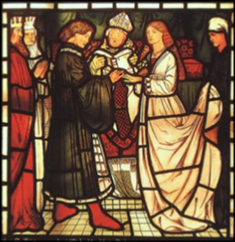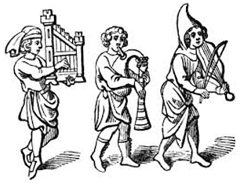


xxxxxThe sensitive love epic Tristan und Isolde was the one and only major work of the German poet Gottfried von Strassburg. Although left unfinished in 1210, its quality marks him out as one of the great German poets of the Middle Ages. Based on the work of a French troubadour, this tender, idyllic love story came to inspire many writers and musicians, including the German composer Richard Wagner, whose opera of that name was produced in 1859. Among other Minnesingers of this time were the Irish and Welsh bards, and the wandering minstrels of Medieval England. In Germany these survived into the 15th century as Meistersingers, and they were to provide another theme for Wagner.
GOTTFRIED VON STRASSBURG c1170 -
Including:
Minnesingers

 xxxxxThe German poet Gottfried von Strassburg is accredited with only one major work, his unfinished love epic Tristan und Isolde, but by the quality of this one poem he has come to be regarded as one of the great German poets of the Middle Ages. Based on the Anglo-
xxxxxThe German poet Gottfried von Strassburg is accredited with only one major work, his unfinished love epic Tristan und Isolde, but by the quality of this one poem he has come to be regarded as one of the great German poets of the Middle Ages. Based on the Anglo-
xxxxxLittle is known of Gottfried's life, but he is thought to have been born about 1170, probably in Strassburg -
 xxxxxGottfried can be numbered among the Minnesingers of this time. These were the singers of the Minnesang or love lyric, and can be likened to the French troubadour, the Irish and Welsh bard, and the wandering minstrel of Medieval England. Famous among these itinerant poets and musicians were Walter von de Vogelweide, Heinrich von Veldeke, Hartmann von Aue, and Wolfram von Eschenbach. In Germany the tradition of the wandering poet, singer and musician was continued into the fourteenth and fifteenth centuries by the Meistersingers, or Master Singers -
xxxxxGottfried can be numbered among the Minnesingers of this time. These were the singers of the Minnesang or love lyric, and can be likened to the French troubadour, the Irish and Welsh bard, and the wandering minstrel of Medieval England. Famous among these itinerant poets and musicians were Walter von de Vogelweide, Heinrich von Veldeke, Hartmann von Aue, and Wolfram von Eschenbach. In Germany the tradition of the wandering poet, singer and musician was continued into the fourteenth and fifteenth centuries by the Meistersingers, or Master Singers -
Acknowledgements
The Marriage: stained-
JO-


